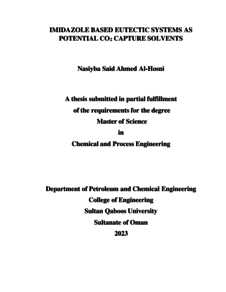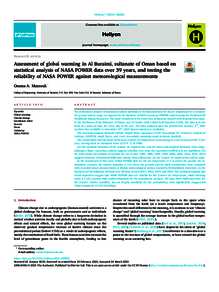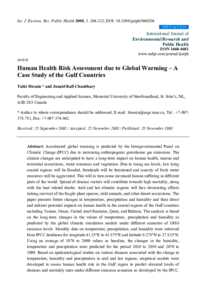وثيقة
Imidazole based eutectic systems as potential CO2 capture solvents.
المصدر
Master's thesis
عناوين أخرى
أنظمة إيميدازول سهلة الانصهار كمذيبات محتملة لالتقاط ثاني أكسيد الكربون
الدولة
Oman
مكان النشر
Muscat
الناشر
Sultan Qaboos University
ميلادي
2023
اللغة
الأنجليزية
نوع الرسالة الجامعية
Master's thesis
الملخص الإنجليزي
Carbon dioxide (CO2) emissions are viewed as the main contributor to global
warming. Therefore, CO2 capture technologies have become vital to mitigate the CO2
emissions. Recently, deep eutectic solvents (DESs) emerged among the several existing
solvents, owing to their harmonizing qualities, low cost, high CO2 absorption, and being
environmentally friendly.
In this work, two different Eutectic Solvent (ES) with a common hydrogen bond
acceptor of Imidazole (IM) and two different hydrogen bond donors, including
diethylenetriamine (DETA) and tetraethylenepentamine (TEPA) were prepared with
molar ratios of 1:1, 1:2, and 1:3. The prospect for CO2 loading in prepared ESs was studied
experimentally using the drop pressure method at molar ratios of 1:1, 1:2, and 1:3,
temperature ranging from 303.15K to 333.15K and pressure of 4 to 16 bar. The design of
experiment (DOE) was applied to study the effect of independent variables that includes
the pressure, temperature, and molar ratios on the CO2 loading of the solvents. The CO2
loading results were correlated based on response surface methodology (RSM) and
analysis of variance (ANOVA). The results revealed that molar ratios, temperature, and
pressure have a significant effect on the loading of CO2. The CO2 loading increased with
increasing pressure and molar ratio, while decreased with increasing temperature. Similar
trend was reported in the literature for several other solvents. Generally, IM:TEPA showed
higher CO2 loading compared to IM:DETA. The maximum CO2 absorption in IM:DETA
of 0.5115 (mol CO2/mol solvent) was observed at 303.15 K, 16 bar, and a 1:2 molar ratio,
while the minimum CO2 loading was 0.1567 (mol CO2/mol solvent) at 313.15 K, 4 bar
and a 1:1 molar ratio. However, the highest CO2 absorption in IM:TEPA was 0.5668 (mol
CO2/mol solvent) at 303.15 K and 16 bar, with a 1:2 molar ratio, while the minimum CO2
loading of 0.1978 (mol CO2/mol solvent) was observed at 313.15K, 4 bar, and a 1:1 molar
ratio. The Fourier transform infrared (FTIR) was used to identify the presence or absence
of specific functional groups as well as the formation of the new functional group after
the mixing. The results revealed that all functional groups of pure components were
present in the spectra, and no new functional groups were observed, indicating the absence
of chemical reactions.
The CO2 loading of prepared Eutectic Solvents with a 1:2 molar ratio was further
investigated with water content of 10, 20, 30, 40, and 50% volume% at temperature and
pressure of 303.15 K and 16 bar respectively. The results showed that the water content
had a significant effect on CO2 loading. It was remarkable to find that the introduction of
water significantly boosted the CO2 loading in both studied systems.
The physical properties, including density(ρ), viscosity(µ), and refractive index
(nD), of IM:DETA and IM:TEPA were measured at atmospheric pressure with 1:1, 1:2,
and 1:3 molar ratios and temperature ranging from 298.15 to 333.15K with a 5 K interval.
The results obtained showed that the density and refractive index decrease directly with
increasing temperature and molar ratio, while the viscosity decreases exponentially with
increasing temperature. The density data of IM:DETA and IM:TEPA ranged between
(1.0219-0.9607g/cc) and (1.0335-0.9779g/cc) respectively.
The thermodynamic properties, including enthalpy, entropy, and Gibbs free
energy, were calculated based on experimental data. The enthalpies of studied solvents
were compared with those of MEA 30wt%. The results reveal that the proposed Eutectic
Solvents required a lower regeneration energy.
الملخص العربي
ينظر إلى انبعاثات ثاني أكسيد الكربون على أنها السبب الرئيسي وراء ظاهرة الاحتباس الحراري، لذلك أصبح استخدام تقنيات احتجاز ثاني أكسيد الكربون حاجة ملحة لمعالجة النتائج المترتبة على انبعاثات ثاني أكسيد الكربون. في الاونة الاخيرة حازت المذيبات سهلة الانصهار (DESs (على الكثير من الاهتمام وذلك بسبب تكلفتها المنخفضة وقدرتها العالية على امتصاص ثاني أكسيد الكربون بالاضافة إلى أنها صديقة للبيئة مقارنة بالمذيبات التقليدية. هذا العمل يهدف إلى تحضير اثنين من المذيبات الجديدة سهلة الانصهار يحتوي الاول على الايميدازول و ثنائي إيثلين ثالثي أمين بينما الاخر يتكون من الايميدازول و رباعي إيثلين البنتامين )DETA:IM و TEPA:IM). تم فحص قابلية الذوبان لثاني أكسيد الكربون في المذيبات المحضرة في النسب الموالرية: :١ ١و ١:٢ و،١:٣ تراوحت درجة الحرارة من ١٥ ٣٠٣, كلفن إلى ١٥ ٣٣٣, كلفن وضغط يصل إلى١٦ بار. تم استخدام برنامج expert-design لدراسة تأثير تغيرات الضغط ودرجة الحرارة والنسب الموالرية في قابلية ذوبان ثاني أكسيد ن. تم ربط نتائج ذوبانية ثاني أكسيد الكربون بنا RSM )وتحليل التباين ًء الكربو على منهجية سطح الاستجابة ) .(ANOVA) أظهرت النتائج أن المتغيرات أعاله لها تأثير كبير في امتصاص ثاني أكسيد الكربون حيث سجلت ذوبانية ثاني أكسيد الكربون عالقة طردية مع كل من الضغط والنسب المولارية بينما العالقة كانت عكسية مع درجة الحرارة. فعلى سبيل المثال كان أعلى ذوبان لثاني أكسيد الكربون في ال DETA:IM )حوالي ,٥١١٥ ٠ عند ٣٠٣,١٥ ُمذيب ) كلفن و ١٦ بار ونسبة موالرية ١:٢ في حين بلغ الحد الادنى ,١٥٦٧ ٠ عند ١٥ ٣١٣, كلفن و٤ بار ونسبة موالرية :١ .١ في المقابل كانت ذوبانية ثاني أكسيد الكربون في نظام (TEPA:IM (أعلى من المذيب آنف الذكر حيث بلغت أعلى ذوبانية لثاني أكسيد الكربون ,٥٦٦٨ ٠ عند ,١٥ ٣٠٣ كلفن و ١٦ بار و ونسبة موالرية ،١:٢ بينما ,١٩٧٨ هي أدنى قيمة ذوبان سجلت لثاني أكسيد الكربون عند ١٥ ٣١٣, كلفن و٤ بار ونسبة موالرية :١ .١ كم تم اجراء تحليل الـFTIR لتحديد المجموعات الوظيفية للعناصر المستخدمة والتغيرات التي تطرأ على تراكيبها الكيميائية بعد المزج. أوضحت النتائج غياب التفاعل الكيميائي بين المواد بعد الخلط، والذي استدل ب خلو التحاليل من مجموعات وظيفية جديدة. كما تم فحص قابلية امتصاص ثاني أكسيد الكربون للمذيبات المحضرة بنسبة موالرية١:٢عند درجة حرارة وضغط ١٥ ٣٠٣, كلفن ١٦ بار على التوالي، ومحتوى ماء )بالحجم%( ،١٠ ،٢٠ ،٣٠ ٤٠ و .٥٠٪ أظهرت النتائج أن إضافة الماء إلى المذيبات المحضرة قد حسن من ذوبانية ثاني أكسيد الكربون. كما تم قياس الخصائص الفزيائية المهمة للمذيبات المحضرة بما في ذلك الكثافة واللزوجة ومعامل الانكسار عند الضغط الجوي ودرجات حرارة من ٢٩٨,١٥ إلى ١٥ ٣٣٣, كلفن. أظهرت النتائج أن الكثافة ومعامل الانكسار يتناقصان بشكل مباشر مع زيادة الحرارة والنسب المولارية، بينما تنخفض اللزوجة بشكل كبير مع زيادة درجة الحرارة. كانت نتائج الكثافة قريبة من كثافة الماء، حيث تراوحت بين )١,٠٢١٩ إلى ,٩٦٠٧ ٠( جم / سم مكعب في نظام )DETA:IM )و ) ١,٠٣٣٥إلى ,٩٧٧٩ ٠( جم / سم مكعب في نظام )TEPA:IM ). كما تم إيجاد قيم الخصائص الديناميكية الحرارية بما في ذلك المحتوى الحراري والانتروبي وطاقة جبس الحرة وتمت مقارنتها بالامين التقليدي )%30MEA). أوضحت النتائج أن المذيبات المحضرة تحتاج إلى طاقة أقل إلعادة استخدامها مقارنة بـ )%30MEA).
قالب العنصر
الرسائل والأطروحات الجامعية






المراجعات 1